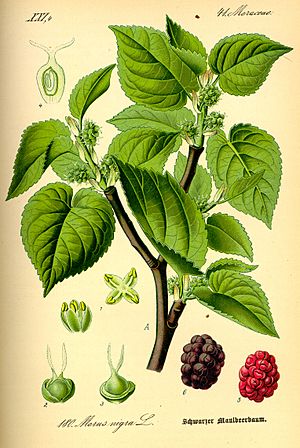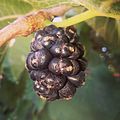Black mulberry facts for kids
Quick facts for kids Black mulberry |
|
|---|---|
 |
|
| Plate from book: Flora of Germany, Austria, and Switzerland (1885) | |
| Scientific classification |
| Nutritional value per 100 g (3.5 oz) | |
|---|---|
| Energy | 180 kJ (43 kcal) |
|
9.8 g
|
|
| Sugars | 8.1 |
| Dietary fiber | 1.7 g |
|
0.39 g
|
|
| Saturated | 0.27 g |
| Monounsaturated | 0.041 g |
| Polyunsaturated | 0.207 g |
|
Protein
|
1.44 g
|
| Vitamins | Quantity
%DV†
|
| Vitamin A equiv. |
0%
1 μg |
| Vitamin A | 25 IU |
| Thiamine (B1) |
3%
0.029 mg |
| Riboflavin (B2) |
8%
0.101 mg |
| Niacin (B3) |
4%
0.62 mg |
| Vitamin B6 |
4%
0.05 mg |
| Folate (B9) |
2%
6 μg |
| Choline |
3%
12.3 mg |
| Vitamin C |
44%
36.4 mg |
| Vitamin E |
6%
0.87 mg |
| Vitamin K |
7%
7.8 μg |
| Minerals | Quantity
%DV†
|
| Calcium |
4%
39 mg |
| Iron |
14%
1.85 mg |
| Magnesium |
5%
18 mg |
| Phosphorus |
5%
38 mg |
| Potassium |
6%
194 mg |
| Sodium |
1%
10 mg |
| Zinc |
1%
0.12 mg |
|
Link to USDA Database entry
|
|
| †Percentages estimated using US recommendations for adults. | |
The black mulberry (also known as Morus nigra) is a type of flowering plant. It belongs to the Moraceae family. People sometimes call it a blackberry, but it is not related to the common blackberry fruit.
This plant originally came from southwestern Asia and the Iberian Peninsula. It has been grown by people for so long that its exact natural home is not fully known. Black mulberries are known for having a very large number of chromosomes.
Contents
What Does the Black Mulberry Look Like?
The black mulberry is a deciduous tree. This means it loses its leaves every autumn. It can grow up to 12 meters (about 39 feet) tall. The tree can also spread out to 15 meters (about 49 feet) wide.
Its leaves are usually 10 to 20 centimeters (4 to 8 inches) long. They are 6 to 10 centimeters (2 to 4 inches) wide. The top of the leaf feels rough. The underside is soft and fuzzy.
The Fruit of the Black Mulberry
The fruit of the black mulberry is a cluster of many small parts. When they are ripe, they turn a dark purple color, almost black. Each fruit is about 2.5 centimeters (1 inch) across.
Black mulberries have a rich, strong flavor. Many people think they taste much better than the white mulberry. The dark color of the fruit comes from natural colors called anthocyanins.
How to Tell Black Mulberries Apart
Sometimes, other types of mulberries are mistaken for black mulberries. This often happens with white mulberries that have black fruit. You can tell a true black mulberry apart by looking at its leaves. The underside of a black mulberry leaf is always fuzzy.
Where Do Black Mulberries Grow and How Are They Used?
Black mulberries are thought to have first grown in the mountains of Mesopotamia and Persia. This area is now part of countries like Armenia and Iran. Today, these trees are planted and grow wild across much of Europe, including Ukraine, and east into China.
You can find them widely in many countries. These include Armenia, Afghanistan, Iraq, Iran, India, Pakistan, Syria, Lebanon, Jordan, Palestine, Israel, and Turkey.
Uses of the Fruit
The fruit of the black mulberry is very tasty and safe to eat. People have grown these trees for a long time just for their fruit. In many places, the fruit is called toot or shahtoot, which means "king's mulberry."
People often make delicious jams and sherbets from the fruit. This is very common in the Middle East.
Black Mulberries in Europe
In Europe, one of the largest groups of black mulberry trees is in Pukanec, Slovakia. There are 470 black mulberry trees growing in the vineyards there.
Historical Uses
In the 1600s, black mulberries were brought to Britain. People hoped they could be used to feed silkworms. Silkworms make silk. However, this plan did not work. Silkworms prefer to eat the leaves of the white mulberry tree instead.
Even though it didn't work for silkworms, many old black mulberry trees can still be found in gardens across Britain. The tree was also used in folk medicine. It was especially used to treat a skin problem called ringworm.
Gallery
See also
 In Spanish: Morera negra para niños
In Spanish: Morera negra para niños









